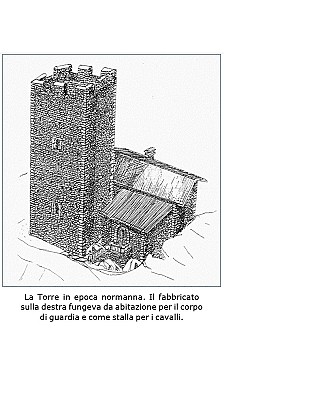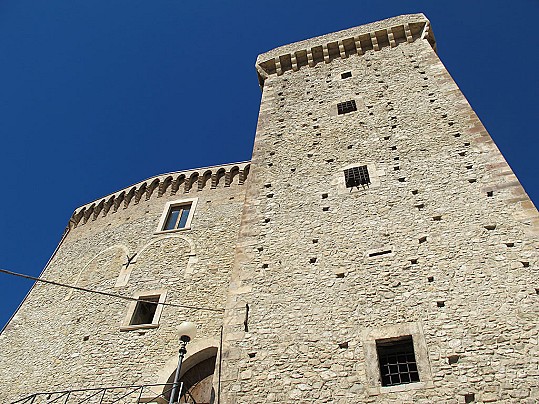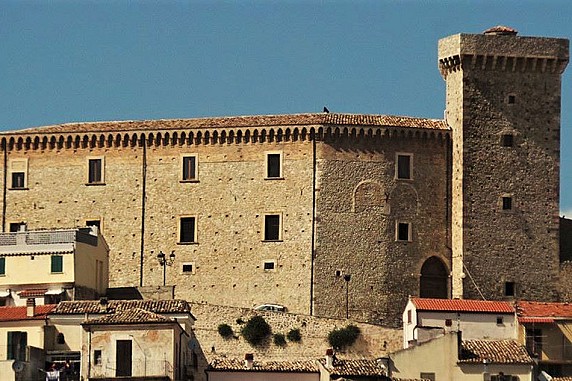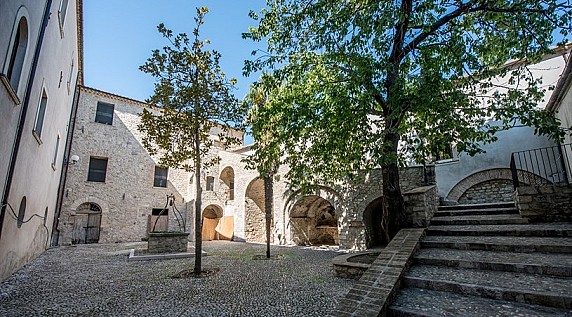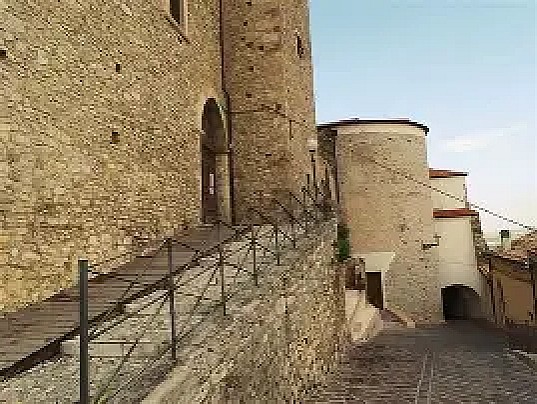La Torre del Tempo: Origini e Ascesa del Castello Ducale
Adiacente alla Chiesa di Santa Maria Maggiore si trova il Castello Ducale con la sua mole possente e con il puntone pentagonale della Torre che ne costituisce la parte originaria.
La Torre nel Tempo: Origini e Ascesa del Castello Ducale Masciantonio
La Torre è stata costruita nel Duecento, in epoca normanna, probabilmente su una preesistente torretta di guardia di epoca longobarda. Faceva parte di un sistema di avvistamento per la difesa del territorio da parte dei nemici invasori. Ha pianta pentagonale ed è decorata da bucature e da una cornice superiore di beccatelli.
Impossibile non salire sulla sua sommità: oltre alla vista di uno splendido panorama, vi permetterà di individuare l’ultimo tratto orientale della Linea Gustav e scoprire le località della battaglia del Sangro, fra le truppe di Hitler, comandate da Kesselring, e l’VIII Armata alleata agli ordini di Montgomery.
Le notizie storiche sull’origine della torre e lo sviluppo del Castello non consentono di ricostruire con precisione le varie fasi costruttive se non collegandole al succedersi delle famiglie proprietarie dagli Orsini nel XIV secolo, ai D’Aquino nel XVII secolo sino ai Masciantonio nel XIX secolo. Infatti, sotto il dominio degli Orsini nel XIV e XV secolo accanto alla torre si sviluppa una struttura in stile gotico-lombardo di due piani, intorno ad un cortile interno, con una cisterna idrica.
Il piano inferiore era destinato agli ambienti di servizio e quello superiore alla residenza, mentre la torre viene suddivisa verticalmente in quattro vani con l’aggiunta di un coronamento aggettante, tipico dell’edilizia militare angioina. Il livello seminterrato è coperto con due crociere di mattoni posti a coltello e sorrette da tre pilasti in laterizio, addossati alle pareti perimetrali maggiori. Al vano si accede attraverso un portale ogivale ornato di pietra concia e dal lato nord-est mediante un’apertura architravata di collegamento diretto con i terrazzamenti esterni.
Gli Orsini dotarono il castello anche di una cappella palatina che costituisce il nucleo originario della chiesa di Santa Maria Maggiore, ponendovi come ornamento esterno due leoni, attualmente decapitati ed inclusi nella muraglia dell’Arco del Purgatorio.
La struttura del Castello si consolida con la famiglia D’Aquino nel XVII secolo con l’aggiunta di due corpi a quello già esistente, elevato di altri due livelli, che conclude la perimetrazione della corte interna. La costruzione di una rampa, sostenuta da quattro archi degradanti, collega il piano terra con quelli superiori.
Nel XIX secolo i Masciantonio trasformano il Castello in una residenza signorile, intervenendo sulla facciata con un rialzamento della linea di gronda e la successiva copertura a capriate a vista ed all’interno con l’adeguamento dei vani di residenza, con l’aggiunta di una scalinata marmorea e la sistemazione dell’ingresso principale, costituito da un portale archi acuto con portone in rovere a cui si giunge salendo una rampa addossata alla muraglia. Un accesso secondario al Palazzo era fornito da un piccolo portale, archi voltato, in pietra lavorata, ubicato lungo la facciata sud-ovest che dava accesso diretto al vano che aveva funzione di frantoio.
 English Version
English Version
Tower and Ducal Palace 
The Tower was built in the thirteenth century, in Norman times, probably on a pre-existing guard tower of the Lombard era. It was part of a sighting system for the defense of the territory from invading enemies. It has a pentagonal plan and is decorated with holes and an upper frame of brackets. Impossible not to climb on its top. In addition to the view of a splendid landscape, it will allow you to locate the last eastern section of the Gustav Line and discover the locations of the battle of the Sangro between Hitler's troops, commanded by Kesselring, and the eighth Army allied under the orders of Montgomery. Some historians claim that, during their visit to Casoli in November-December 1943, the two generals climbed the Tower to study the tactical chessboard of the armies deployed in the field. Ducal Palace The building complex of the Doge’s Palace and the Tower is commonly called “Lu Castelle” (Th’r Casle), in the dialect of Casoli, and is the pride of the community. The Tower is older than the Palace, whose construction took place in stages over the centuries by some owners. This is the constructive process over the centuries. First phase – The Orsini Princes, during the 14th and 15th centuries, built the first layout of the palace (Fig. 1) in continuity with Tower 'A' and stables 'B'. Bodies 'C', two storeys, and 'D', one storey, were built. The lower floor of the "C" area and the "D" block were used as warehouses for storing grain and other foodstuffs, while the upper one of the "C" part had a residential function. Particularly interesting is the architecture of the basement level of the body "C", which has cross vaults of bricks placed with knives, resting on brick pillars located on the two longer perimeter walls. The room is accessed through an ogival portal of worked stone. Second phase – On May 2, 1642, the D’Aquino family purchased the Castle from Francesco Filomarino, Prince of Rocca d’Aspide. The D’Aquino family had the merit, in the following two centuries, to perform important interventions to the Palace, consisting in the expansion of the pre-existing, through the construction of the "E" and "F" zones of Fig. 2. The building complex took on a closed architectural form, organized around the inner courtyard with the cistern in the center for collecting rainwater. The D’Aquinos also made changes to the "D" Body of the Palace with the construction of a basement and the raising of a roof. In the courtyard, a stepped ramp (Fig. 3), supported by two sloping round arches, was built between the 17th and 18th centuries, which still serves as a link between the courtyard and the rooms on the upper floors. Third phase – In 1916, the Masciantonio family, through Concetta Di Benedetto, (daughter of Domenicantonio di Benedetto), who had married Raffaele Masciantonio, took over the possession of the Castle. In this phase the final volumetric and aesthetic completion of the building complex took place (Figs. 4 and 5). The "E" and "F" areas were transformed into an elegant home for the family and the main facade underwent an important intervention, consisting in raising the roof through the installation of wooden trusses on newly built perimeter walls, to bring the house to a higher altitude. The crowning of the roof was embellished with a protruding decorative element, consisting of projecting brick shelves, which hold sharp arches. Fourth phase – In 1982 the Masciantonio family sold the Castle to the Municipality of Casoli, which carried out lots of renovations, improvements, consolidation and elimination of architectural barriers. The municipal administration is carrying out functional planning of the interior.
Castello Ducale
https://abruzzoturismo.it/it/destinazioni/castello-di-casoli-ch
